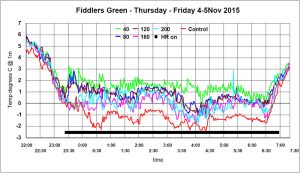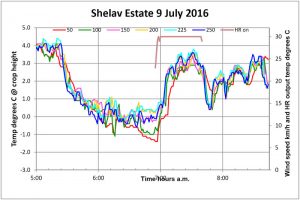Warm Air is an Alternative to Frost Protection Sprinklers
During the last three years we have been trialling and evaluating Heat Ranger to establish the level of protection from frost that can be reasonably expected.
1. Evaluation Process
Heat Ranger has a rotating nozzle that directs warm air over the top of a crop to replace cold air with warmer air and hence reduce the radiation and convection losses from the ground surface. The rotation speed is set at approximately 3 minutes per full rotation.
In order to measure the effective temperatures we locate 5m masts at varying distances from the Heat Ranger machine and measure the temperature profile before, during and after the machine has been operated. The masts have temperature sensors located in small Stevenson style screens and are located at cordon height (typically 60 – 70 cm above the ground) an at 2.5m and 5m. At least one mast will also be fitted with an anemometer.
The output air temperature from the machine, the fan and nozzle rotation speed, are all monitored during an event. The mast temperatures are measured at 1 minute intervals to ± 0.1°C. This equipment is designed and built by Harvest Electronics in Masterton and is telemetered to its website so that the information is available within a minute of the measurements being recorded.
The Heat Ranger operational data is also telemetered to our control site in Hamilton and integrated with the Harvest data.
2. Temperature Monitoring
As temperatures vary within a vineyard and certainly between vineyards having a control mast more than 500m away from the machine means that we have to monitor a site with and without the Heat Ranger machine going to establish the relationships between the masts sites during a Leading the Revolution in Climate Management Systems number of frost events to ensure that we have consistent relationships and can be confident of our results when the machine is running.
We have found that it is very unlikely that the timing of temperature changes across a kilometer is the same and while we can plot temperature against distance and time there are lags. In most situations it is simpler to look at the minimum temperatures during an event and the overall time that a temperature may be below ‐1°C or ‐2°C or ‐3°C. We know that most susceptible crops such as grapes can tolerate temperatures down to ‐1°C and slightly below, for short periods of time.
3. Site selection
One issue that we have had to accept is that if a site already has some existing form of frost protection, then the grower is very reluctant to turn that off once the onset of spring plant growth has commenced. On sites such as this we can only monitor winter frost temperatures, which may or may not equate to crop protected.
The ideal sites are those that do not have frost protection in place, but have a history of serious losses and are large enough to provide areas outside the range of the machine. They also need to be in significant areas where grapes, and other target crops are grown.
Our initial development work was done on black currants, but this is a relatively low value crop and there is only a relatively small number of hectares of the crop in New Zealand.
Because crops are not normally grown where there is a high frost risk every year, there can be seasons when no challenging events occur. This is very frustrating for us but is very welcome for the grower.
To get access to sites with a high challenge but unencumbered with existing equipment has been a challenge in itself and we have relied on the goodwill of a number of supportive and dedicated people to support our programme as these sites are usually located in more remote areas where communications with telemetry can be difficult to maintain.
4. Machine operation
Our trials have shown that the best nozzle operating temperature is between 30°C – 32°C. If we run it with a higher nozzle temperature, the ground and crop drag coefficient is insufficient to hold the warm air down on the crop and we lose the warm air to the atmosphere above. If we run at lower Nozzle temperatures we have less energy spread over the crop and so the overall temperature lift is less. What we have found is that a reduction in heat input once the blanket of warm air has been established can still maintain a very effective warm air cover.
The machine burns LPG to provide the Heat and the gas flow is controlled with a valve managed by the internal electronics microprocessors. The same gas is used to power the 2 litre Subaru Boxer engine that drives the fan so that there is only one fuel source.
The normal setting for the machine is to start automatically at +1°C so that it can begin before the air temperatures get below zero, so that it is not having to play catch up.
5. Results
5.1. Fiddlers Green Site at Waipara
We did locate a vineyard site with a supportive grower that had no frost protection at Fiddlers Green in Waipara and we were lucky enough to get two frost events in the spring of 2015. The most significant event occurred on the morning of the 5th November and the results are shown in the chart below.

One of the challenges in setting up trial areas and external control sites is to establish an appropriate control monitoring site that has equivalent temperature profiles to use for comparisons. Because eat Ranger has such a large radius of influence our control station has to be at least 500m away from the machine. In this instance we had the control in a separate block behind a hedge so that it could not be affected. What we did not appreciate until we were checking for crop damage two weeks later was that we should have had our measuring masts spaced 50m not 40m as the machine protected crop out beyond 300m in this event.
In this particular event at round 5:30am the temperature of the nozzle output had fallen to 18 degrees and kept dropping over the next hour and a half as the gas supply ran down. On re checking when shutting down, our grower on site, Ross, noticed that one of the two isolating valves connecting the pallets had not been turned on and he had been running on one pallet only. Despite this the warm air that had been built up was able to be maintained with the reduced heat input and the crop was saved.
5.2. Wairau Valley Site – Shalev Estate
During the 2016 winter season we were able to locate a Heat Ranger machine in the frost zone in the Upper Wairau Valley inland from Blenheim where the existence of an inversion layer varies. When there is no inversion layer, the use of wind machines and helicopters becomes problematic and in this area.
The site was where a new vineyard was being established and we were able to locate the machine on the west side of the area which had been assessed by a climate expert as being a very difficult site.
We were unable to get a suitable “Control” for this site and we were reliant on the vineyard owner turning the machine on and off manually as we were unable to get reliable coverage for machine communications system, but we were able to locate the Harvest base station where we could get coverage for the temperature monitoring.
During this time we did get 2 events where we were able to demonstrate 2 or more degrees lift in temperature out to 250m.
The first event was on the 9 July 2016 when there was a late morning frost and the vineyard owner turned on the machine late at 6:50am and saw an immediate temperature lift of between 2 and 3 degrees. He turned it off an hour later and the temperature dropped back down again.

With no suitable control site the best way to demonstrate the change in temperature is to start and stop the machine during a frost event.
We repeated this on the evening of the 9th August when temperatures began to decline rapidly at 7pm and the machine was turned on 8pm and there was an increase in temperature of 2°C at 250m within 5 minutes. After half an hour the machine was turned of and the temperatures at 250m fell by 2°C within a few minutes. Shortly afterwards the wind shifted and increased and the temperatures at the site increased naturally above ‐1°C.
5.3. Forrest Estate – Mountain View Vineyard
We relocated the machine to Forrest Estate, another site in Marlborough that is in a lower risk area, where the vineyard wanted to evaluate the machine during flowering to see if raising temperatures between 8am and 11am in a cool morning would improve fruit set. As happens in these situations he did not get a cool morning during flowering to run a test.
6. Response from out trial sites
Ross Trowsdale at Fiddlers Green, believes that by having Heat Ranger on site he was able to protect his 10ha grape area and believes that he would have been severely damaged without it. At Waipara this was a normal frost season (with damage where vines were not protected). He ran the machine on through 2 serious frosts as well as testing in low temperature conditions for reliability. We are satisfied that the operational issues are working as they should and that the machine has done what we set out to do, that is to raise the temperatures by incorporating heat to “protect” his vineyard area.
We also commissioned an independent survey of 21 local vineyards in Waipara after the two November 2015 frosts of which the most severe was on the 4‐5th November where we had ‐3degrees for 7 hours, to see how other vineyards in the area had been effected.
The results of the survey are on the back page of the attached brochure but I have also included them in this summary for completeness.
- The 2 vineyards using water sprinklers lost between 0 – 5% of the crop
- The 7 vineyards using helicopters lost between 5 ‐ 30%
- The 11 using wind machines with or without extra frost pots lost between 5 – 50%
- The 2 without any protection lost between 45 – 100%
- The Heat Ranger block lost no crop
At Shalev Estate we were unable to maintain an appropriate “control” because of there was not a comparable location outside the range of the Heat Ranger Machine so we had to rely on episode testing within a frost event and this clearly showed a significant lift in temperatures out to 250m from the machine.
We currently have the machine at Forrest Estate, but there has not been a frost this spring.
Noise levels
We had independent noise level tests carried out on the Forrest Estate vineyard and the noise level at 300m was 45dB. The 55db level was achieved at 130m from the machine.
The Marlborough district Plan states Noise levels measured at 300 metres from the wind machine shall not exceed 55 dBA
Input parameters
The 30 degree heated air temp and 3 minute rotation speed works well. Doing Evaluation work in frost conditions is never easy but the results speak for themselves. The interest is certainly there as growers appreciate that there is a viable alternative out there.
